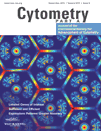|
Comments:
|
Tru Count Tubes were used in combination with the labeling of fusion partners with DiI and DiO probes in a three-color assay for quantification of fused and unfused cells during syncytia formation experiments. We have previously shown that the labeling of fusion partners with fluorescent lipophilic probes (DiI and DiO) and analysis by flow cytometry, allow the quantification of cell fusion during HIV-envelope dependent syncytia formation (Huerta L. 2002. Cytometry 2002, 1; 47(2): 100-106; Huerta L. et al. J Virol Methods. 2006, 138(1-2): 17-23). Here, the absolute cell number and viability were determined in 4-day co-cultures of Jurkat HIV-1 envelope-expressing cells (Env+ cells) with CD4+ cells, using the labeling with lipophilic probes and True Count tubes in a three-color flow cytometry assay. For determination of the absolute number of cells during syncytium formation, the following gating was applied:
1) Viable cells were selected using a forward scatter (FSC-H) versus side scatter (SSC-H) dot plot, where a region was delineated excluding cell debris and dead cells (R1 in Fig. 1A).
2) Then, a FL1-H versus FL2-H dot plot was constructed for cells in R1.
By applying compensation as described in section 4.2, the DiI and DiO fluorescence allowed the discrimination of syncytia and unfused cells as double and single fluorescent particles, respectively (Fig. 1B).
Fluorescent beads were detected in the FL4-H fluorescence channel clearly separated from red and green cells (Fig. 1C). The plot was constructed without threshold on forward scatter (FCS) due to the small size of the beads.
Once proper regions were determined for the clear distinction of syncytia, unfused cells, and fluorescent beads, a fixed number of beads were acquired. The absolute number of each cell population was calculated as: (number of beads acquired/number of total beads in the tube) X number of cells acquired.
|
|
Quality control:
|
To standardize voltage settings and compensation conditions, as well for definition of regions corresponding to fused and unfused cell populations, unlabeled and single-labeled cell suspensions were used as controls for each experiment and for each day in a given experiment. Minor adjustments of setting respective to those of the first day were needed for the analysis from the 3rd and 4th day samples, due to a slight but detectable loss of fluorescence intensity of the lipophilic probes.
The amount of aggregated cells was restricted to 2-3 % of the double fluorescent particles, as demonstrated before on the base of the enhanced red fluorescence in the fused cell population due to FRET (Ref. 24 of the manuscript). In addition, cell aggregation was also assessed in co-cultures of Env+ non fusogenic cells with CD4+ cells, in which the amount of cell aggregates was low (Ref. 24 and Figure 3C of the manuscript). As indicated before, the amount of cell aggregates is brought to a minimum by gently pipetting of the cell suspension immediately before FACS analysis (Ref. 24).
The performance of the True Count Tubes has been evaluated in numerous publications, so that they are considered a standard to obtain the absolute number of cell populations by flow cytometry (e.g., J Vis Exp. 2012 Sep 16;(67):e4302. doi: 10.3791/4302).
|

